Chillerama Blu-ray Movie
HomeChillerama Blu-ray Movie 
Wadzilla / I Was a Teenage Werebear / The Diary of Anne Frankenstein / Zom-B-MovieImage Entertainment | 2011 | 4 Movies | 120 min | Unrated | Nov 29, 2011
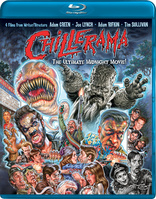
Movie rating
6.5 | / 10 |
Blu-ray rating
| Users | 0.0 | |
| Reviewer | 4.0 | |
| Overall | 4.0 |
Overview
Chillerama (2011)
It's the closing night at the last drive-in theater in the US and Cecil B. Kaufman has planned the ultimate marathon of lost film prints to unleash upon his faithful cinephile patrons. Four films so rare that they have never been exhibited publicly on US soil until this very night! What could possibly go wrong?
Starring: Richard Riehle, Adam Rifkin, Ray Wise, Lin Shaye, Tania RaymondeDirector: Adam Green (VI), Joe Lynch (V), Adam Rifkin, Tim Sullivan (IX), Bear McCreary
| Horror | Uncertain |
| Comedy | Uncertain |
| Fantasy | Uncertain |
| Musical | Uncertain |
| Action | Uncertain |
Specifications
Video
Video codec: MPEG-4 AVC
Video resolution: 1080p
Aspect ratio: 1.78:1
Original aspect ratio: 1.85:1
Audio
English: DTS-HD Master Audio 5.1
Subtitles
English SDH, Spanish
Discs
25GB Blu-ray Disc
Single disc (1 BD)
Playback
Region A (locked)
Review
Rating summary
| Movie | 4.0 | |
| Video | 4.0 | |
| Audio | 4.0 | |
| Extras | 4.0 | |
| Overall | 4.0 |
Chillerama Blu-ray Movie Review
Bad Taste Snack Shop. No Nutritional Value. Fun for All.
Reviewed by Michael Reuben November 29, 2011Anthology horror films are a subgenre unto themselves. They operate from the premise that some stories work better when they're short. Creepshow, Tales from the Hood, Tales from the Darkside, The House That Dripped Blood, even the TV-friendly Trilogy of Terror all used different framing devices to link several such stories into one movie. Chillerama is the latest entry, made for a reported $300,000, but with boundless enthusiasm and just enough of the winking nostalgia deployed by the makers of Grindhouse to keep the atmosphere light. But where Quentin Tarantino and Robert Rodriguez allowed their homages to Seventies exploitation films to become almost an academic essay on the subject, the four directors of Chillerama don't require viewers to be experts on bad horror films to get the joke. You just have to enjoy poking fun at cheesy dialogue, intentionally bad effects, preposterous plots and disgusting glop. It also helps if you already understand, as most viewers do, that horror films are fundamentally about sex, because there's no question what rating Chillerama would have gotten. It has enough nudity, simulated sex and bodily emissions for ten NC-17s. To say that the humor of Chillerama is juvenile is to state the obvious. What elevates the film's stupidity above the mainstream (and certainly above standard Hollywood fare) is the intensity and focus with which its creators pursue each puerile premise to its logical conclusion—and frequently beyond. In this respect, though in not many others, Chillerama often reminded me of certain routines by Monty Python's Flying Circus. The Pythons, too, often began with a premise that was silly, childish, offensive or all of the above. Then they'd make it funny by pushing it rigorously past the point where most comics would have lost heart. In one notoriously offensive Python sketch, a man attempted to make funeral arrangements for his mother, only to discover that the undertakers were cannibals. To increasing howls of protest from the audience, the funeral director persuaded the client to join them in dining on the maternal remains. "Tell you what", he said, with crystal clear logic. "We'll eat your mother, and if you feel guilty afterward, we'll dig a grave and you can throw up into it." If you can appreciate the mania for bad taste behind that routine, Chillerama should appeal to you, even when you're exclaiming, "Yech!" (which will be often).
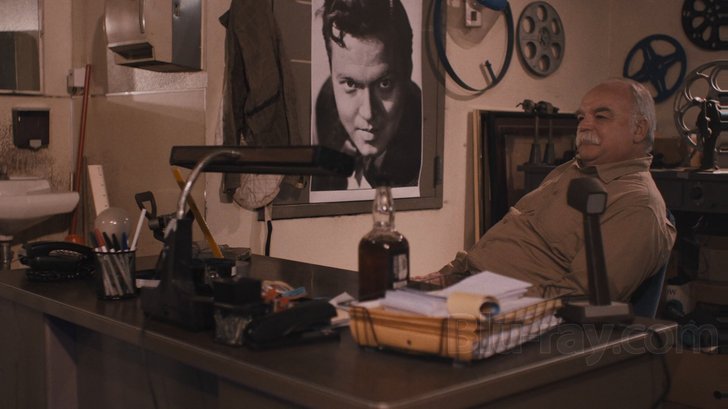
It's the last night at Kaufman's Drive-In, before the place is shuttered and razed for new development. Long-time proprietor Cecil Kaufman (Richard Riehle) is a showman in the great tradition of Orson Welles, whose picture hangs in his projection room. Kaufman wants to go out with a bang, and he's showing a marathon of rare one-of-a-kind prints from his personal collection. Among the patrons arriving for this memorable night are a former employee, Toby (Corey Jones), and his friends, Mayna (Kaili Thorne), on whom he has a crush, and Ryan (Brendan McCreary), who has a crush on an employee at the concession stand named Desi (Laura Ortiz); a married couple, Rick and Deb Marshall (A.J. Bowen and Briana Mackay), who have brought their baby to a horror film fest out of nostalgia, because he was conceived at Kaufman's Drive-In; and Miller (Ward Roberts), a junior VP at Blumps, the company that bought the property from Kaufman, who is keeping an eye on the place for the night, accompanied by a hot number named Laura (Olivia Dudley), who has promised to make the evening worth his while. Having been systematically introduced to these various individuals, do you think any or all of them might be in trouble before the evening is over? But I've skipped over where Chillerama begins, which is, appropriately enough, in a graveyard with a man, later identified as Floyd (Miles Dougal), digging up his ex-wife in order to exact necrophiliac revenge on her corpse. But is it really necrophilia when the violator is a zombie and the corpse also turns out to be undead? Floyd is, uh, injured and staggers off to his job, which just happens to be at Kaufman's Drive-In. His condition (for lack of a better term) results in a small mix-up with buttered popcorn, which causes Floyd to become Patient Zero in an epidemic of zombie-ism—coming soon to a drive-in near you! But Floyd's particular brand of zombie-ism doesn't involve compulsive consumption of brains or viscera. Its victims are seized by an irresistible urge to fornicate with any randomly available body (or body part). In the meantime, though, there are Kaufman's rarities to watch. First up is "Wadzilla", written, directed by and starring Adam Rifkin (Detroit Rock City). A homage to Fifties films about giant monsters created by atomic mutation that destroy a major city, "Wadzilla's" most obvious reference is The Blob. But the giant gooey predator threatening humanity in Rifkin's parody isn't from outer space. It's the result of an experimental drug prescribed by a cigarette-puffing physician, Dr. Weems (Ray Wise), to one Miles Munson (Rifkin), an unfortunate fellow with a low sperm count. (In general, there's more smoking in "Wadzilla" than in Mad Men.) The drug is supposed to make Miles's existing sperm stronger, but it just makes them bigger, causing Miles agonizing pain whenever he gets aroused. Dr. Weems takes him off the drug, but it's too late. Arriving for a blind date with a gorgeous woman named Louise (Sarah Mutch), Miles experiences an episode that permanently eclipses There's Something About Mary for extremity of embarrassment, and the result is a very large and still-growing single-celled organism roaming the streets of Manhattan, eating dogs, people and just about everything else. The military is summoned, under the command of a general (Eric Roberts) whose name is one of a seemingly endless string of double entendres with which the film climaxes (yes, I just said that). As in Ghostbusters 2, the Statue of Liberty plays a key role. As in the original Ghostbusters, a shower of white glop drenches everyone in sight leading to what is surely the longest string of cumshot jokes ever recorded in any film, mainstream or pornographic.

Chillerama Blu-ray Movie, Video Quality 
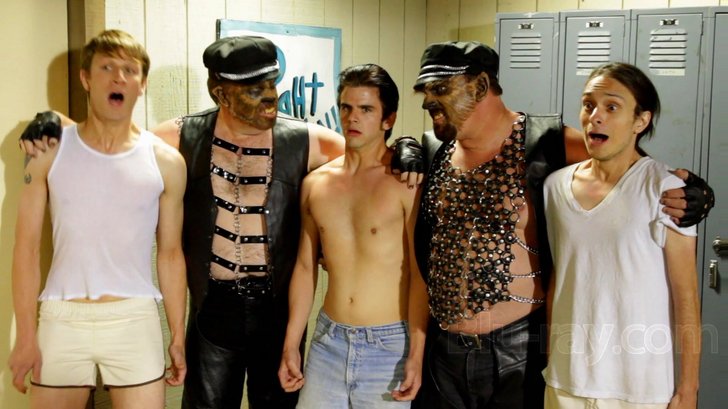
I wasn't able to find definitive information on the photographic process, but there are several references in the commentary to digital capture, and given (a) the tight budget, (b) the heavy reliance on green screen and digital post-processing, and (c) the use of the same cinematographer, Will Barratt, on each segment, it's likely that digital photography was used throughout. Digital origination is the only explanation I can imagine for Image Entertainment's ability to get away with using a BD-25 for a two-hour film with over an hour of extras, nearly all of them in hi-definition (despite what it says on the Blu-ray case). By some miracle, and the efficiencies of the AVC codec, compression artifacts aren't an issue on this disc. But Image is really pushing it. Chillerama played film festivals and toured major cities in a kind of modern "road show" engagement, but it was clearly aimed at the home video market via download, DVD and Blu-ray, and the 1080p, AVC-encoded image has been formatted at 1.78:1 accordingly. Since we're dealing with three (or four, if you count the "Deathication" segment) short films and a framing segment, each with a distinctive look, you can expect a wide array of visual styles. As in "Strawberry Fields", nothing is real. From the moment the jokey animated titles dissolve into Floyd (Miles Dougal), the drive-in assistant and secret zombie, who oozes fluorescent blue fluid you don't really want to know about, it's clear that the images in Chillerama can't be judged by normal standards. In general, the images in the framing "Zom-B-Movie" section are the most realistic, once Floyd returns to his place of work. Colors are muted in the low light of car interiors and stronger under the fluorescents of the concession stand and Kaufman's office and projection booth. Detail is generally good, even in low-light conditions (because it's never truly dark at a drive-in).

Chillerama Blu-ray Movie, Audio Quality 

The 5.1 soundtrack for Chillerama is presented in DTS lossless, and the sound editing varies by segment. For "Zom-B-Movie", which is the portion that can be called "contemporary", the mix utilizes the full surround field, with plenty of activity in the rear channels, especially with Kaufman's massive P.A. system and, once the zombie attack gets underway, crashes, grunts and shrieks from all over. (As director Lynch says in the commentary, you'll never be able to hear the famous "Wilhelm scream" quite the same way again.) The other three segments (or, four, depending on how you count) make very little use of the surrounds except to fortify an occasional big effect in front, because these are supposed to be low-budget films from an era when even stereo was a luxury. Still, the sound mixers had fun. When "Wadzilla" begins, Dr. Weems's advice sounds hollow and detached from the screen. This was frequently the case in cheap films with rushed ADR, and the effect recurs throughout "Wadzilla", to the point where you get used to it. In "I Was a Teenage Wearbear", the switch from dialogue to studio-recorded, lip-synched singing is extremely obvious, as it always was in those Frankie and Annette films. At one point, a character's speech goes completely out of synch—a joke that happened by accident during an early screening and produced such a laugh that the directors kept it. Director Sullivan co-wrote the songs for "Werebear" with the segment's composer Patrick Copeland. An additional song was written by Robbie Vinton (son of Bobbie), who appears in the segment. Scoring for other portions was supplied by Andy Garfield (Frozen) and Bear McCreary (Battlestar Galactica). It all strikes just the right note of mock seriousness. Be sure to stay through the credits for a musical number by Hitler that had to be cut from "Diary" for running time. It's worth it.
Chillerama Blu-ray Movie, Special Features and Extras 
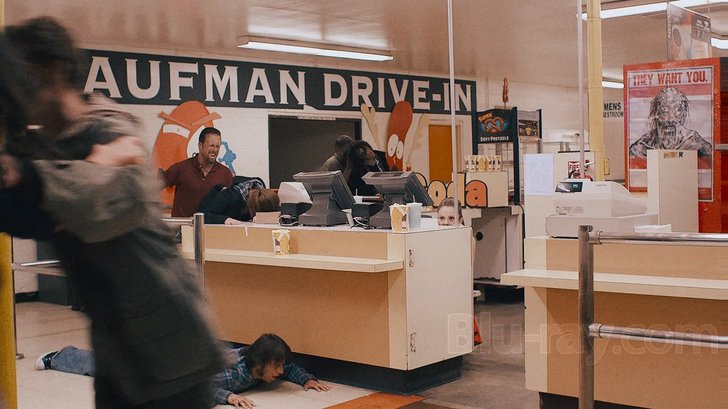
- Directors' Video Commentary: In addition to talking through the feature, Rifkin, Green, Sullivan and Lynch can be watched recording their commentary in the upper left hand quadrant of the screen. I fail to see what this video element adds to the experience, and if I had the choice, I'd remove it from the screen. The image isn't large enough to reveal facial expressions (or even show whose lips are moving), and there isn't anything in the video portion of the program to justify losing a significant portion of the film image on which the directors are commenting. That flaw aside, it's an informative commentary. Although the members of the group constantly rib one another, the mutual respect and pride in their joint accomplishment are obvious, and each director is allowed to talk without major interruption about his particular segment. It probably helped stimulate the conversation that none of the four had seen the finished product before the commentary recording session in August 2011; the version they'd seen at Comic-Con the previous month lacked final color grading and complete effects, and each director had done some additional editing since then. Among other interesting stories, the quartet describe how the project dates back to 1999, when Rifkin was directing, and Sullivan was helping to produce, the little-seen Detroit Rock City (which concerned the misadventures of a high school band trying to attend a KISS concert). Sullivan and Rifkin discovered a mutual love of schlock "B" movies and exploitation horror films, especially those made with wit and no budget by the likes of Roger Corman and Troma Entertainment. After many delays and changes in concept and personnel, the two joined forces with Lynch and Green. Each director describes technical challenges and practical solutions and, in some cases, reveals who turned them down for parts in the film. (The role of drive-in owner Cecil Kaufman was written for Keith David, who considered the part for nine months before declining.) They also discuss their inspirations, and at one poignant moment they lament the fact that so many young filmmakers are dismissive of the horror classics that inspired them (e.g., John Carpenter's Halloween is "too slow").
- The Making of "The Diary of Anne Frankenstein" (HD; 1.78:1; 23:18): Primarily an extended interview with writer-director Adam Green, this documentary also includes interviews with star Joel David Moore and stunt coordinator Kane Hodder (who played the monster, Meshugannah). Among other topics, Moore and Green discuss the care they took to ensure they didn't treat the historical Anne Frank disrespectfully. Moore also describes the challenges of acting while speaking the faux German which is his character's only language.
- "Wadzilla" Deleted Scenes (HD; 1.78:1; 6:05): There are seven scenes, most of which survive in one form or another in the finished film. These versions are primarily interesting for a look at the unfinished effects, although one scene provides a longer version of the monster attacking New York. A portion of the final scene, in which Dr. Weems is interviewed by a TV reporter, plays during the film's credits.
- "I Was a Teenage Werebear"
- Behind the Scenes (HD; 1.78:1; 22:00): A well-organized and informative history of the segment, featuring interviews with writer-director Sullivan, co-producer Brian McCulley, composer Patrick Copeland, stars Lockhart and Troy and most of the rest of the cast.
- Deleted Scenes (HD; 1.78:1; 14:28): There are twelve scenes. Many are short additions or extensions, but several are extended or additional musical numbers, including an alternate ending.
- "Zom-B-Movie" Deleted Scenes (HD;1.78:1; 4:03): The first of three scenes is from "Deathication"; you have been warned. The second shows more of Kaufman's routine before starting the evening's show. The third has Kaufman encouraging his former employee Toby in the latter's romantic aspirations with Mayna.
- Famous Monsters (HD; 1.78:1; 5:42): Interviewed at Comic-Con on July 22, 2011 for www.famousmonstersoffilmland.com, the four directors discuss their influences and the origin of the project.
- Salfen Comic-Con Interview (SD; 1.85:1, non-enhanced; 7:52): Also interviewed on July 22, 2011, the four directors give a brief overview of the film to webmaster Paul Salfen.
- Trailers (HD; 1.78)
- Chillerama (2:14)
- I Was a Teenage Werebear (2:02)
- Wadzilla (2:40)

Chillerama Blu-ray Movie, Overall Score and Recommendation 
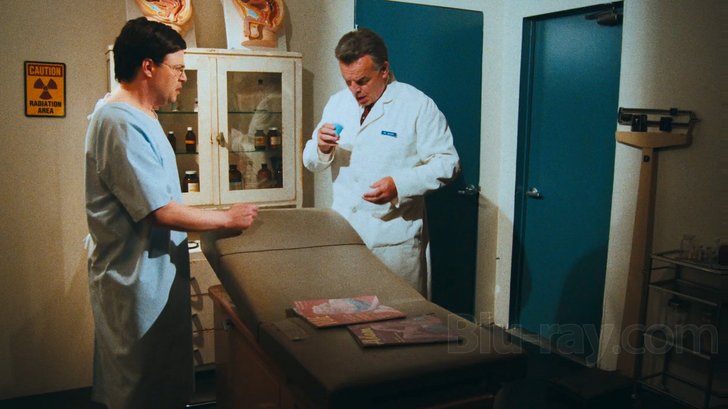
Bad taste is a staple of comedy, and just when I think it's been worn out by being misused and overused by hacks who lack both the wit and the courage to create anything truly interesting or outrageous, something like Chillerama comes along and catches me by surprise. Humor is subjective, and Chillerama may not be your thing, but you should be able to tell from this review and the accompanying screen shots. With that disclaimer, the disc is highly recommended.
Similar titles
Similar titles you might also like

House
1985

Waxwork
1988

Zombeavers
2014

Poultrygeist: Night of the Chicken Dead
2006

Class of Nuke 'Em High
1986

Dog Soldiers
Collector's Edition
2002

Attack the Block
2011

Deathgasm
2015

VFW 4K
2019

Leprechaun
1993

Cursed
Collector's Edition
2005

The Horror of Party Beach
1964

Another WolfCop
WolfCop II
2017

The Monster Club
1981

Scary Stories to Tell in the Dark 4K
2019

Masters of Horror: Season One, Volume I
2005

Mom
1989

Bite
2015

Tales of Halloween
2015

Late Phases: Night of the Lone Wolf
Late Phases
2014